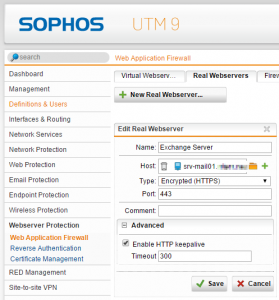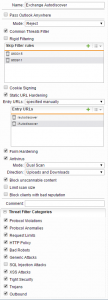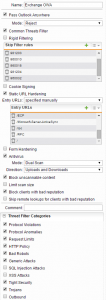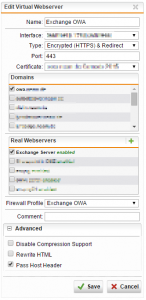current status of this guide: 18th July 2016 (Exchange 2016 compatible)
There are many tutorials about securing Exchange webservices with the Webserver Protection from Sophos UTM but some are outdated or are not working any more. So I will show you a working configuration and will keep this tutorial up2date. Login to your Sophos UTM WebAdmin, deactivate the DNAT and configure your Exchange server under “Real Webservers”:
upload your SSL certificate to the Sophos UTM store to publish the site via the virtual webservers:
there are three Exchange webservices: ActiveSync for pushmail with mobile devices, Outlook Anywhere (RPC) for secure sync with Outlook clients and the Outlook Web App for accessing your mails via browser. I combined all services in a single profile and built a second profile for autodiscover.
Skip Filter rules:
960015
960911
Static URL Hardening:
/autodiscover
/Autodiscover
Firewall-Profile for OWA:
Skip Filter rules:
960015
981203
960010
960018
981204
960032
981176
Static URL Hardening:
/ecp
/ECP
/ews
/EWS
/Microsoft-Server-ActiveSync
/oab
/OAB
/owa
/OWA
/rpc
/RPC
/mapi
/MAPI
/
after this you need to configure both virtual webservers for the URLs autodiscover.company.com and owa.company.com:
at the end you need to configure exceptions to make everything work. We will configure four exceptions for specific URLs:
Title: AV exception for OWA
Skip: Antivirus
Virtual Webserver: “Exchange OWA”
for paths:
/owa/ev.owa*
/OWA/ev.owa*
Title: exception for autodiscover
Skip: Static URL Hardening
Virtual Webserver: “Exchange Autodiscover”
for paths:
/autodiscover/*
/Autodiscover/*
Advanced: Never change HTML during Static URL Hardening or Form Hardening
Title: exception for OWA
Skip: Static URL Hardening
Virtual Webserver: “Exchange OWA”
for paths:
/ecp/*
/ECP/*
/ews/*
/EWS/*
/Microsoft-Server-ActiveSync*
/oab/*
/OAB/*
/owa/*
/OWA/*Advanced: Never change HTML during Static URL Hardening or Form Hardening
Title: exception for Outlook Anywhere
Skip: (everything:) Antivirus, Static URL Hardening, Form Hardening, Cookie Signing, Bad Reputation, Outbound HTTP Policy, Protocol Anomalies, Protocol Violations, Bad Robots, Request Limits, SQL Injection Attacks, Generic Attacks, Trojans, Tight Security, XSS Attacks
Virtual Webserver: “Exchange OWA”
for paths:
/rpc/*
/RPC/*
/mapi/*
/MAPI/*
Feel free to discuss this in the comments. I saw some “ModSecurity” messages at one of my customer and skipped additionally the rules 981176, 960009, 900000, 960911, 960904, 960035 and Outlook Anywhere stops working! I don’t know why skipping some rules is breaking the RPC service… just keep that info in mind. I’m using the above configuration at all of my customers.















42 Responses
Hi, do you have this working 100%? – I have it setup on my mobile and it makes errors:
method=”POST” statuscode=”403″ reason=”url hardening” extra=”No signature found”
on this one: url=”/Microsoft-Server-ActiveSync”
Thanks for a great guide though :-)
Br. martin
Yeah I corrected the tutorial. The exception for this folder is your virtual “Exchange OWA” server, not “Exchange Autodiscover”, sorry :)
Follow up here :-)
https://www.astaro.org/gateway-products/web-server-security/55015-exchange-2013-not-working-through-waf.html#post300689
Hi michel
I have problem with my exchage 2010 and utm 9.3
I didi configure my sopho with thier officle doc but when try to open owa or outlook anywhere get loging prompt repedetly
I didnot confihure anything for autodiscover could it this be the reson?
If this is the root of the issue
My cert has 4 names and non is autodiscover can i use for example remote.mydomain.com to configutr my auto discover or it must called autodiscover?
Thanks
Hi Shahin,
Outlook is looking automatically for “autodiscover.yourcompany.com” :-/ you need to point this DNS name to the same address as “owa.” or your “remote.”
Hi Michel,
I really appreciate to take the time an answer my question,
We hosting many domains in our Exchange org the domain called internally .local and external domains belong to different customers so I dont think the Autodiscover is really an issue here.
Just one question:
You didn’t configure any Authentication profile so your configuration dont need any right? should I still configure the Exchange virtual directory with basic Authentication?
Thanks
The Authentication goes trough the webserver protection. Authentication profile is only for using OTP tokens on /owa
This is realy streang that Sophos dont talk about this in thier article:
https://sophserv.sophos.com/repo_kb/120454/file/Exchange%20WAF%20How%20to%209%202.pdf
So if we dont want to use OTP there is no need to configure the Reverse Authentication and no need to add our DC to the servers onder the Authentication services right?
with your config does the end user see the Exchange form Base Authentication page or Basic Authentication?
or this depend on which authentication is setup at IIS level?
Thanks
This article is not working :)
If you don’t use OTP you don’t need to configure authenticatoin on the Sophos UTM. I often configure form-based authentication as the user likes it more :)
Hi Michel,
Thanks again for reply,
I am realy new to UTM and always worked with TMG, so thank you for being patient and answering my questions.
If I understood you correctly your configuration should work for OWA and outlook anywhere and also for smartphones right?
On the exchange level how should we configure the authentication for the exchange virtual directory? right now all of the directories have Windows and Basic authentication enabled.
should we change the OWA and ECP to form based authentication and leve the rest as they are with basic auth?
I’m always patient ;)
yes it will work for the three ways to access your mailbox (Outlook Web Access “/owa” within a browser, Outlook Anywhere “/rpc” and Pushmail “/Microsoft-ActiveSync”). You don’t need to change anything at the directories. You can change form based in the Exchange Management Console in serverconfiguration / client-access / Outlook Web App.
Keep asking questions :)
Very kind of you,
I decided to go ahead with your config.
Just with one difference that I dont have the autodiscover.mydomain.com in my cert so I hoop this one is not going to create a problem.
so outlook anywhere is not working with the config above?
Hi Michel
Unfortunatly with above config the outlookanywhere dont work( didnt test the phons yet)
I can login to the owa only in the internet explorer if i try in other browser get an error
I did check the logs and see the ids that michel in his last part of his config talked abut I did add them to exception with The rest of the ids but still no change.
when try to access the OA i get the loging screen repedetly.
Any ideas guys
Guys my exchane OA and activesync and owa is finally working
We decided not to use the reverse authentiaction as i think still is not really working good and sophos has his issues with it and no need for the reverse authantication let the backend server do the authentication
I did use the Michel and the offical doc of sophos and get it to work
Thank you Michel
Hi Michel, do you know the OWA App for iOS / Android? Some of our customer are using this app but it doesn´t work, although it should because it is using the same infrastructure as native OWA. Do you know where the problem could be?
Hi Otto,
the OWA App connects to Microsoft, stores (!) your credentials and goes to your own Outlook Web App access. I think the Microsoft Azure service can’t connect over the webserver protection. You need to check your waf logs for this, maybe we need to write an additional tutorial for this.
I would suggest that you stop using this app and use the built-in mail apps to synchronize you mails. It’s very unsecure that Microsoft stores your credentials + have access to all your data stored in the Exchange database. See her for more information: https://blog.winkelmeyer.com/2015/01/warning-microsofts-outlook-app-for-ios-breaks-your-company-security/
Thanks so much for this great writeup. For now we are running without firewall profiles for simplicity – more interested in being able to control access to the various virtual directories by network location (under site path routing).
One thing I noticed was that when we had HTTPS & Redirection on the virtual servers, users would get an Outlook popup regarding allowing autodiscover to configure settings etc. We switched both VSes to just HTTPS and that seems to have gone away.
WAF is definitely a little quirky/touchy!
Curious what version of UTM you are on. We had been happy with 9.321 for a loooong time but it seemed to me that WAF wasn’t working right with Exchange on it. Moved to 9.355-1 for now and it seems to function properly.
Eh, spoke too soon. It’s just not stable. Outlook randomly disconnecting (while still fine for others) on people and refusing to reconnect. Had to switch back to DNAT for now.
Having a DNAT just for SMTP to the same ip shouldn’t affect WAF on that ip, correct?
A DNAT for SMTP is ok, WAF is only working on http and https. Can you update to the latest 9.4 version? I use this tutorial always at new installations and I haven’t problem yet.
It absolutely amazing: skipping some Rule IDs really breaks WAF as you wrote above. My logs were full of warnings after I excluded 900000, 960911, 960904, 960035 and outlook Anywhere could not connect over RPC/HTTP
The warnings were like:
ModSecurity: Warning. Match of “rx ^(?i:(?:[a-z]{3,10}\\\\s+(?:\\\\w{3,7}?://[\\\\w\\\\-\\\\./]*(?::\\\\d+)?)?/[^?#]*(?:\\\\?[^#\\\\s]*)?(?:#[\\\\S]*)?|connect (?:\\\\d{1,3}\\\\.){3}\\\\d{1,3}\\\\.?(?::\\\\d+)?|options \\\\*)\\\\s+[\\\\w\\\\./]+|get /[^?#]*(?:\\\\?[^#\\\\s]*)?(?:#[\\\\S]*)?)$” against “REQUEST_LINE” required. [file “/usr/apache/conf/waf/modsecurity_crs_protocol_violations.conf”] [line “52”] [id “960911”] [rev “2”] [msg “Invalid HTTP Request Line”] [data “RPC_OUT_DATA /rpc/rpcproxy.dll?cas.mydomain.lan:6002 HTTP/1.1”] [severity “WARNING”] [ver “OWASP_CRS/2.2.7”] [maturity “9”] [accuracy “9”] [tag “OWASP_CRS/PROTOCOL_VIOLATION/INVALID_REQ”] [tag “CAPEC-272”] [hostname “mail.mydomain.de”] [uri “/rpc/rpcproxy.dll”]
ModSecurity: Warning. String match within “.asa/ .asax/ .ascx/ .axd/ .backup/ .bak/ .bat/ .cdx/ .cer/ .cfg/ .cmd/ .com/ .config/ .conf/ .cs/ .csproj/ .csr/ .dat/ .db/ .dbf/ .dll/ .dos/ .htr/ .htw/ .ida/ .idc/ .idq/ .inc/ .ini/ .key/ .licx/ .lnk/ .log/ .mdb/ .old/ .pass/ .pdb/ .pol/ .printer/ .pwd/ .resources/ .resx/ .sql/ .sys/ .vb/ .vbs/ .vbproj/ .vsdisco/ .webinfo/ .xsd/ .xsx/” at TX:extension. [file “/usr/apache/conf/waf/modsecurity_crs_http_policy.conf”] [line “88”] [id “960035”] [rev “2”] [msg “URL file extension is restricted by policy”] [data “.dll”] [severity “CRITICAL”] [ver “OWASP_CRS/2.2.7”] [maturity “9”] [accuracy “9”] [tag “OWASP_CRS/POLICY/EXT_RESTRICTED”] [tag “WASCTC/WASC-15”] [tag “OWASP_TOP_10/A7”] [tag “PCI/6.5.10”] [hostname “mail.mydomain.de”] [uri “/rpc/rpcproxy.dll”]
My exclusions are now for and Webservices:
960015
960010
960018
981204
960032
981176
981203
Btw: still got this nasty one left. Note: it allows access but warns.
ModSecurity: Access allowed (phase 1). Operator GT matched 0 at ENV. [file “/usr/apache/conf/waf/base.conf”] [line “14”] [id “900000”] [hostname “mail.mydomain.de”] [uri “/rpc/rpcproxy.dll”]
Followup:
when using “rigid filtering” in the firewall profile, Rule 960009 must be skipped for /Microsoft-Server-ActiveSync.
[security2:error] ModSecurity: Warning. Operator EQ matched 0 at REQUEST_HEADERS. [file “/usr/apache/conf/waf/modsecurity_crs_protocol_anomalies.conf”] [line “66”] [id “960009”] [rev “1”] [msg “Request Missing a User Agent Header”] [severity “NOTICE”] [ver “OWASP_CRS/2.2.7”] [maturity “9”] [accuracy “9”] [tag “OWASP_CRS/PROTOCOL_VIOLATION/MISSING_HEADER_UA”] [tag “WASCTC/WASC-21”] [tag “OWASP_TOP_10/A7”] [tag “PCI/6.5.10”] [hostname “mail.mydomain.de”] [uri “/Microsoft-Server-ActiveSync”]
Btw. for WAF ActiveSync testing during Sophos SG migrations without hacking/rooting mobile phones, you can use the Windows 10 mail app and select Advanced Setup -> MS Active Sync when creating a mailbox profile. Then you can comfortably change windows hosts file.
Hi Michael
Amazing Article! thank you!
Do you by any chance know if there are some issues with this configuration if you set up a redirection from ‘/’ to ‘/owa’ ?
If have set it up that way, with the Site Path Rules for all the Other Paths but I didn’t get it to work without any Firewall Profile.
Hi Philipp,
I would recommend doing this directly on the Microsoft IIS
On he ‘exception for Outlook Anywhere’, you says select everything and then list individual items. I assume Sophos added some as ‘outbound’ and ‘true file type control’ wasn’t listed. Should I skip them as well?
Hi Paul,
yeah I would skip them as well.
Setting up the ‘Exchange OWA’ Firewall profile, I get an:
‘The list of skipped filter rules contains the following required infrastructure rules: 981176, 981203, 981204. Disabling a required infrastructure rule can lead to attacks not being blocked by the Web Application Firewall.’
It lets me save it.
Yeah that is a normal warning :-)
Paul Fischer:
Do Not use infrastructure rules in exceptions!
When you look at WAF live logs, there is and ID before the infrastructure ID, it’s THAT ID you need to put in the exception :-)
https://community.sophos.com/kb/en-us/121446
best regards
Martin
Hi Michel
Do you have any documentation you can share on publishing an HTTPS connection to a Windows RDS (Remote Desktop Server) through UTM using port 442 or another port, as port 443 is used for OWA and we only have a single external IP Address?
Thank you.
Hi Ian,
I think this is very easy, just configure port 442 in the virtual webserver and configure your remote desktop connection gateway in “mstsc” with “server.customer.com:442”
Thanks Michel,
I have it working, kind of. I get to the RDWeb page no issue, I can log in and get the RDP icon, the web page has the correct secure server certificate with the same name as the RDS server in the browser. When I connect to the RDP session, the RDP client launches and requests User credentials, I enter these and I get the error:- “Your computer can’t connect to the remote computer because the Remote Desktop Gateway server address requested and the certificate subject do not match.” When I look at the certificate in the error, it is the mail certificate for OWA & Exchange.
I have added a third network card to the UTM and used this for the RDS connection so as to separate the RDS & Mail connections and it makes no difference.
1. I have both Mail & RDS Certificates loaded onto the Sophos UTM.
2. I have ensured that the RDS rule in the “Web Application Firewall” has the correct certificate applied to it.
3. I have ensured that the RDS certificate is applied to the RDS server in the Config and that the Mail Certificate is not on the server.
I do only have 1 external IP Address, but as I am using 2 different NIC’s for the Mail and RDS I did not think this would be an issue.
I have googled this error and tried most of the fixes, none have worked.
If you have any insight that would be greatly appreciated, thank you. :-)